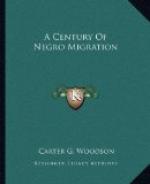They were arriving much faster than they could be assimilated. The State of Pennsylvania had about exterminated slavery by 1840, having only 40 slaves that year and only a few hundred at any time after 1810. Many of these, of course, had not had time to make their way in life as freedmen. To show how much the rapid migration to that city aggravated the situation under these circumstances one needs but note the statistics of the increase of the free people of color in that State. There were only 22,492 such persons in Pennsylvania in 1810, but in 1820 there were 30,202, and in 1830 as many as 37,930. This number increased to 47,854 by 1840, to 53,626 by 1850, and to 56,949 by 1860. The undesirable aspect of the situation was that most of the migrating blacks came in crude form.[9] “On arriving,” therefore, says a contemporary, “they abandoned themselves to all manner of debauchery and dissipation to the great annoyance of many citizens."[10]
Thereafter followed a number of clashes developing finally into a series of riots of a grave nature. Innocent Negroes, attacked at first for purposes of sport and later for sinister designs, were often badly beaten in the streets or even cut with knives. The offenders were not punished and if the Negroes defended themselves they were usually severely penalized. In 1819 three white women stoned a woman of color to death.[11] A few youths entered a Negro church in Philadelphia in 1825 and by throwing pepper to give rise to suffocating fumes caused a panic which resulted in the death of several Negroes.[12] When the citizens of New Haven, Connecticut, arrayed themselves in 1831 against the plan to establish in that city a Negro manual labor college, there was held in Philadelphia a meeting which passed resolutions enthusiastically endorsing this effort to rid the community of the evil of the immigration of free Negroes. There arose also the custom of driving Negroes away from Independence Square on the Fourth of July because they were neither considered nor desired as a part of the body politic.[13]
It was thought that in the state of feeling of the thirties that the Negro would be annihilated. De Tocqueville also observed that the Negroes were more detested in the free States than in those where they were held as slaves.[14] There had been such a reaction since 1800 that no positions of consequence were open to Negroes, however well educated they might be, and the education of the blacks which was once vigorously prosecuted there became unpopular.[15] This was especially true of Harrisburg and Philadelphia but by no means confined to large cities. The Philadelphia press said nothing in behalf of the race. It was generally thought that freedom had not been an advantage to the Negro and that instead of making progress they had filled jails and almshouses and multiplied pest holes to afflict the cities with disease and crime.
The Negroes of York carefully worked out in 1803 a plan to burn the city. Incendiaries set on fire a number of houses, eleven of which were destroyed, whereas there were other attempts at a general destruction of the city. The authorities arrested a number of Negroes but ran the risk of having the jail broken open by their sympathizing fellowmen. After a reign of terror for half a week, order was restored and twenty of the accused were convicted of arson.




